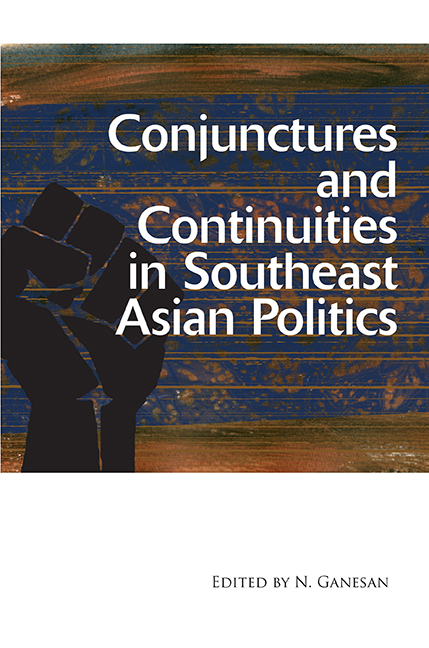Book contents
- Frontmatter
- Contents
- Acknowledgements
- List of Abbreviations
- Contributors
- 1 Conjunctures and Continuities in Southeast Asian Politics
- 2 (Re)Assessing the EDSA “People Power” (1986) as a Critical Conjuncture
- 3 The Road to Doi Moi in 1986: Domestic Dimensions
- 4 The 1988 Uprising in Myanmar: Historical Conjuncture or Praetorian Redux?
- 5 Cambodia's Historical Conjunctures and their Significance
- 6 Changing the Rules: Historical Conjuncture and Transition in Indonesia
- 7 The Resistible Rise of Thaksin Shinawatra: Crisis, Change and the Collapse of Thailand's Democracy
- 8 The March 2008 General Election in Malaysia as a Historical Conjuncture
- 9 Conclusion: Conjunctures and Continuities in Southeast Asia
- Index
2 - (Re)Assessing the EDSA “People Power” (1986) as a Critical Conjuncture
Published online by Cambridge University Press: 21 October 2015
- Frontmatter
- Contents
- Acknowledgements
- List of Abbreviations
- Contributors
- 1 Conjunctures and Continuities in Southeast Asian Politics
- 2 (Re)Assessing the EDSA “People Power” (1986) as a Critical Conjuncture
- 3 The Road to Doi Moi in 1986: Domestic Dimensions
- 4 The 1988 Uprising in Myanmar: Historical Conjuncture or Praetorian Redux?
- 5 Cambodia's Historical Conjunctures and their Significance
- 6 Changing the Rules: Historical Conjuncture and Transition in Indonesia
- 7 The Resistible Rise of Thaksin Shinawatra: Crisis, Change and the Collapse of Thailand's Democracy
- 8 The March 2008 General Election in Malaysia as a Historical Conjuncture
- 9 Conclusion: Conjunctures and Continuities in Southeast Asia
- Index
Summary
Having paved the way for restoring democracy after over a decade of Marcos' authoritarianism, popular views take EDSA People Power as a critical turning point in Philippine political history. This chapter seeks to take another look at this idea by evaluating the socio-political and discursive contexts within which it developed. Exploring two pathways, it shows, firstly, that the extent to which the EDSA revolt may be considered as a critical conjuncture depends significantly on the assessment of, and meanings attached to, the Marcos years. In other words, that this event looms large as a critical turning point notwithstanding the “return to good old days” in Philippine politics that it ushered in, is a reflection of two parallel and mutually reinforcing developments: (1) the hegemony of global discourse on democratization and (2) the strong anti-Marcos sentiments in the post-EDSA years that segments of the elite, civil society and international players promoted for their interests, both altruistic and self-serving. Secondly, this chapter argues that EDSA cannot be assessed simply in terms of its immediate effects on formal economic and political structures. One has to look at the democratization process “from below”, which necessarily takes time, and away from formal democratic institutions, to see the spaces it opened and the political energies it strengthened. A set of broader analytic lenses — ones that consider discursive resonances, that de-centre analysis from central state institutions, and that consider long-term changes in political culture — must be deployed in order to uncover the changes set in train by this event.
The EDSA “People Power” revolt of 1986 stands out in political iconography and ideography of democratization, both within and beyond the Philippines. Hailed as a paragon of peaceful political change, it is touted as having inspired through “demonstration effect” the struggles for democracy elsewhere in the region and beyond.
- Type
- Chapter
- Information
- Publisher: ISEAS–Yusof Ishak InstitutePrint publication year: 2013

